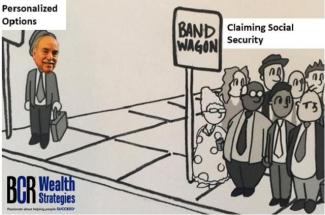
Covid-19 and Claiming Social Security Retirement Benefits
The current covid-19 virus has changed many people’s financial plans, at least in the short term, and, at most, for the rest of their lives. For those approaching retirement or Social Security claiming age, Social Security strategies that have been previously decided may be obsolete.
For most people with retirement accounts, the value of the assets in those accounts has decreased. If you’ve just lost your job you may have cash flow needs. Others may worry that the Social Security trust fund is about to go broke. Let’s look at these as unemotionally as we can.
Cash flow needs cause the most immediate financial stress. Because markets are down from recent highs its generally considered a poor time to take distributions from retirement accounts. That’s because obtaining a given amount from those accounts decreases account value a disproportionally large amount.
Starting Social Security payments early is generally a bad idea if you have alternatives. To obtain the so-called full benefit, people should claim at their Full Retirement Age (FRA). For most situations, individuals can claim Social Security as early as age 62, but this is not FRA. Claiming at 62 decreases the benefit by 25%, and locks in a permanent decrease. On the other hand, for every month after FRA that you wait to claim your benefit increases by 2/3%; that’s 8% per year. That’s a good return if you can wait. Also, the later you claim this benefit the larger the cost of living adjustments will be, and the larger the survivor benefit will be.
For someone retiring today, their full retirement age is 66. Retiring at 70 versus retiring at age 62 provides a whopping 76% increase. After age 70, there’s no increase in benefits. Starting Social Security benefits is a very complicated decision, so you should consult a knowledgeable advisor before doing so.
What are other sources of money to alleviate cash flow issues? Revisiting your budget and cutting down on expenditures is a great first step. Our expense habits have changed significantly since we started staying home so much.
Reverse mortgages, while not for everyone, can provide cash flow until the markets’ value returns. It is money that does not have to be repaid if the borrowers, or at least one of them, still lives in the house.
For those who have taxable investment accounts (non-IRA, 401(k), etc.), the broker may have asset-based loans available. These are typically interest only loans (only the interest needs to be paid back monthly) at relatively low rates (typically tied to an interest rate index, that changes periodically). Bear in mind that a portion of the assets in your account will not be available to you to sell if you need the money. Once set up you may borrow on a regular basis, until you reach a maximum provided in the agreement.
Cash value in life insurance also is a potential source – but remember distributions from life insurance cash value decreases the amount of payoff at the insured’s death. This is, however, a tax-free option.
Working longer, if an option, both decreases the cash flow need and also decreases the amount of money needed to finance your retirement.
Home equity lines of credit enables you to tap into the value in your home. The line of credit can be withdrawn monthly, for example, but bear in mind, this some of the loan usually has to be paid back on a monthly basis.
Claiming Social Security retirement benefits early is an expensive way to shore up cash flow needs. There are non-Social Security options that may be available, and you should consider them before jumping on the Social Security benefit bandwagon.
-Harold Sasnowitz-

